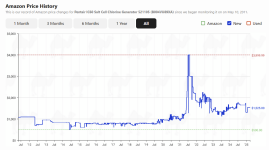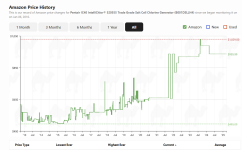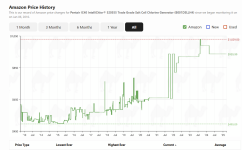I think this is a good plan. Any new product may have minor issues after its release. Letting others sort that out and getting a proven (existing) product at a discount makes good financial sense.This is quite the conundrum... I'm starting season 6 with my current cell. I should go check the operating hours. I have been thinking about how I will navigate the loss of this cell and getting a new one. I was initially hoping to make it until the new models were out, but if I can save a decent amount of dough, it may be worth getting the old version and waiting to see how the IC plus works out long term. Plus having a cell on the shelf with some known life left in it sounds like the best way to navigate the loss of a cell.
--Jeff
You are using an out of date browser. It may not display this or other websites correctly.
You should upgrade or use an alternative browser.
You should upgrade or use an alternative browser.
- May 23, 2015
- 25,693
- Pool Size
- 16000
- Surface
- Plaster
- Chlorine
- Salt Water Generator
- SWG Type
- Pentair Intellichlor IC-60
Just note that even in “known products” there are lemons. I consider my current IC60 to be a bit on the lemony side. I only got three full years out of it before I started noticing water weep from under the membrane pad electronics. It’s also giving me a low salt alarm even though everything is fine with my pool and the thermistor in the IC checks out ok. The weeping body seal is a catastrophic failure - basically the potting compound used to hold the electronics in place and seal the plate assembly up to the IC body has failed. So it’s just a matter of when the unit will fail. This failure mode is known and it’s somewhat rare but it did happen.
But I generally agree that of cost is your most important concern, then grabbing a cheap replacement now makes a lot of sense.
But I generally agree that of cost is your most important concern, then grabbing a cheap replacement now makes a lot of sense.
Davegnh
Bronze Supporter
- Jul 31, 2021
- 299
- Pool Size
- 11000
- Surface
- Plaster
- Chlorine
- Salt Water Generator
- SWG Type
- Pentair Intellichlor IC-40
Im still seeing the IC60 in the range of $1400-$1700 even at the low end still double the cost of the generics. I was hoping cost would be sub $1000 for replacement cell.


The IC40 im seeing better pricing for around $1000-1250. I guess a pipe dream to think it will get back to the $650 pricing pre-covid



The IC40 im seeing better pricing for around $1000-1250. I guess a pipe dream to think it will get back to the $650 pricing pre-covid

Attachments
- May 23, 2015
- 25,693
- Pool Size
- 16000
- Surface
- Plaster
- Chlorine
- Salt Water Generator
- SWG Type
- Pentair Intellichlor IC-60
I guess a pipe dream to think it will get back to the $650 pricing pre-covid
Pretty much. That and ruthenium prices went through the roof. With only a small number of Asian manufacturers making the plates, the prices will not come down any time soon. I suspect the latest talk of tariffs will also make them more expensive …
I'm seeing lots in the low $1300s. Do your due diligence if it's EC or not.Im still seeing the IC60 in the range of $1400-$1700 even at the low end
Link
Link 2
My replacement IC60 in June of 2019 was $770 delivered to my door.I guess a pipe dream to think it will get back to the $650 pricing pre-covid
- May 23, 2015
- 25,693
- Pool Size
- 16000
- Surface
- Plaster
- Chlorine
- Salt Water Generator
- SWG Type
- Pentair Intellichlor IC-60
My replacement IC60 in June of 2019 was $770 delivered to my door.. They jumped right after that for the season and then the dumpster fire happened that's been raging since.
Yeah, mine was like $1200 in 2021 when I got it.
- Jul 21, 2013
- 65,062
- Pool Size
- 35000
- Surface
- Plaster
- Chlorine
- Salt Water Generator
- SWG Type
- Pentair Intellichlor IC-60
Not just making the plates but refining the rare earths...Pretty much. That and ruthenium prices went through the roof. With only a small number of Asian manufacturers making the plates, the prices will not come down any time soon. I suspect the latest talk of tariffs will also make them more expensive …
WSJ:How China Beat Out the U.S. to Become the Top Player in Rare-Earths Refining
In truth, the U.S. already has abundant supplies of rare earths, but it relies on China to refine them. That is because the U.S. has lost much of its capacity to process minerals, while China has become the world’s dominant refiner of rare earths, cobalt, copper and many other metals.
...
In the case of rare earths, the U.S. mines around 12% of the world’s supply, putting it only behind China, according to the United States Geological Survey. Most of the bounty comes from a massive deposit in the Mountain Pass mine in California.
But the U.S. exports about two-thirds of its rare earths to China. It has little choice: China is responsible for around 85% of the world’s rare earth refining. Chinese companies then turn the ore into the final product—rare-earth magnets—and export the magnets back to the U.S.
Similarly, the U.S. sends a chunk of its substantial supplies of copper to China for processing. Even America’s lone nickel mine sends its nickel concentrate abroad to Canada for smelting.
Until the 1990s, the U.S. was a major refiner of minerals and metals. But then China emerged as the dominant player, powered by its cheap labor force and looser environmental regulations of a sector that can be highly polluting. The voracious need of Chinese manufacturers for raw materials during the country’s years of explosive growth was also a boon for Chinese refiners.
Today, the sheer scale of China’s refining industry makes it difficult for others to compete. According to industry estimates, the cost of building a refinery plant in China is a third of the cost in the U.S.
- May 23, 2015
- 25,693
- Pool Size
- 16000
- Surface
- Plaster
- Chlorine
- Salt Water Generator
- SWG Type
- Pentair Intellichlor IC-60
Not just making the plates but refining the rare earths...
WSJ:How China Beat Out the U.S. to Become the Top Player in Rare-Earths Refining
In truth, the U.S. already has abundant supplies of rare earths, but it relies on China to refine them. That is because the U.S. has lost much of its capacity to process minerals, while China has become the world’s dominant refiner of rare earths, cobalt, copper and many other metals.
...
In the case of rare earths, the U.S. mines around 12% of the world’s supply, putting it only behind China, according to the United States Geological Survey. Most of the bounty comes from a massive deposit in the Mountain Pass mine in California.
But the U.S. exports about two-thirds of its rare earths to China. It has little choice: China is responsible for around 85% of the world’s rare earth refining. Chinese companies then turn the ore into the final product—rare-earth magnets—and export the magnets back to the U.S.
Similarly, the U.S. sends a chunk of its substantial supplies of copper to China for processing. Even America’s lone nickel mine sends its nickel concentrate abroad to Canada for smelting.
Until the 1990s, the U.S. was a major refiner of minerals and metals. But then China emerged as the dominant player, powered by its cheap labor force and looser environmental regulations of a sector that can be highly polluting. The voracious need of Chinese manufacturers for raw materials during the country’s years of explosive growth was also a boon for Chinese refiners.
Today, the sheer scale of China’s refining industry makes it difficult for others to compete. According to industry estimates, the cost of building a refinery plant in China is a third of the cost in the U.S.
And there are days in China where the air is basically unbreathable. Think USA 1960’s smog only a million times worse.
- Jul 21, 2013
- 65,062
- Pool Size
- 35000
- Surface
- Plaster
- Chlorine
- Salt Water Generator
- SWG Type
- Pentair Intellichlor IC-60
So the cost for the SWG is in exchange for breathing cleaner air.And there are days in China where the air is basically unbreathable. Think USA 1960’s smog only a million times worse.
As long as "they" are willing to do the dirty work I am happy to pay the price.
Turbo1Ton
Gold Supporter
- Dec 26, 2019
- 1,995
- Pool Size
- 14500
- Surface
- Plaster
- Chlorine
- Salt Water Generator
- SWG Type
- Pentair Intellichlor IC-40
Well, I just checked the hours on my IC40 and it is showing 4000 hours (20 and 40% lights come on after it scrolls). I checked it about 6 times because I find that hard to believe with 5 seasons on the clock (installed Feb 2020). So probably gonna let it ride this season and just save the money altogether.Yeah. Financially it makes every sense to scoop up the cheap spare. But I'm broke with 3+ years left on mine .
*obvious calculated risks of the new or old cell having an early failure not withstanding.
--Jeff
We don't know where the cutoff is for the hour lights. 4001 could trigger 60%, or maybe halfway between at 5000 does. And the same goes on the high side. Is 6999 still 60%, 7999 ?I checked it about 6 times because I find that hard to believe with 5 seasons on the clock (installed Feb 2020).
IMO 60% could be 4001 to 7999.
But you upsized nicely, so here's to hoping it's only middle aged.

- May 23, 2015
- 25,693
- Pool Size
- 16000
- Surface
- Plaster
- Chlorine
- Salt Water Generator
- SWG Type
- Pentair Intellichlor IC-60
The new ICplus units will finally give diagnostic info … never liked how Pentair always hid that information.
Warranty now includes an hour limit and a yearly limit.
The cell tracks hours of production and there should be a way to see this information.
29. What is the warranty of the new IntelliChlor Plus & LT SCGs as TradeGrade Products?
a. Three years for IntelliChlor Plus Salt Chlorine Generators (or 10,000 hours, whichever comes first) and two years for IntelliChlor LT Salt Chlorine Generators (or
6,000 hours, whichever comes first). For more warranty information, refer to www.pentair.com/warranty.
The cell tracks hours of production and there should be a way to see this information.
29. What is the warranty of the new IntelliChlor Plus & LT SCGs as TradeGrade Products?
a. Three years for IntelliChlor Plus Salt Chlorine Generators (or 10,000 hours, whichever comes first) and two years for IntelliChlor LT Salt Chlorine Generators (or
6,000 hours, whichever comes first). For more warranty information, refer to www.pentair.com/warranty.
- Jul 21, 2013
- 65,062
- Pool Size
- 35000
- Surface
- Plaster
- Chlorine
- Salt Water Generator
- SWG Type
- Pentair Intellichlor IC-60
There are 8,760 hours in most years.Warranty now includes an hour limit and a yearly limit.
The cell tracks hours of production and there should be a way to see this information.
29. What is the warranty of the new IntelliChlor Plus & LT SCGs as TradeGrade Products?
a. Three years for IntelliChlor Plus Salt Chlorine Generators (or 10,000 hours, whichever comes first) and two years for IntelliChlor LT Salt Chlorine Generators (or
6,000 hours, whichever comes first). For more warranty information, refer to www.pentair.com/warranty.
If you run your pump 24/7 and SWG more than 38% you will hit the 10,000 hours in less than 3 years.
3 year warranty is for Trade Grade cells.
What is warranty for replacement cells?

___________________________________________________________

________________________________________________________

IntelliChlor® Plus & LT Salt Chlorine Generators
The IntelliChlor® Plus & LT Salt Chlorine Generators are new and improved designs that use ordinary table salt to help make pools cleaner, clearer, and silkier.
Attachments


Pool Product Warranty Information
Whether you are planning a pool party for friends and family or prefer the serene sensation of a calm pool, Pentair has the pool and spa solutions just for you.
- Jul 21, 2013
- 65,062
- Pool Size
- 35000
- Surface
- Plaster
- Chlorine
- Salt Water Generator
- SWG Type
- Pentair Intellichlor IC-60
Interesting new Usage Based column on the warranty.
I guess Pentair was doing too many warranty replacements of undersized cells.
It is a reason to greatly oversize the new cells to get the maximum calendar warranty.
I guess Pentair was doing too many warranty replacements of undersized cells.
It is a reason to greatly oversize the new cells to get the maximum calendar warranty.
Davegnh
Bronze Supporter
- Jul 31, 2021
- 299
- Pool Size
- 11000
- Surface
- Plaster
- Chlorine
- Salt Water Generator
- SWG Type
- Pentair Intellichlor IC-40
I would rather have a warranty based on hours. I never liked how most pool equipment is based on years. Most of us live in an area with partial year pool usage but we have the same warranty on years. A warranty you should only cover defects in manufacturing and you could technically run your cell hard for a year and use up all its life. Or use it gently and it fails at year four with barely any usage and not covered.
The three years still applies.I would rather have a warranty based on hours.
The warranty is 3 years or 10,000 hours, whichever comes first.
10,000 hours is 417 days, which is 583 lb chlorine gas at 1.4 lb per day for a 40 size cell.
That's 2,330 ppm FC in a 30,000 gallon pool.
That's 558 gallons of 12.5% sodium hypochlorite or 637 lb trichlor.
700 gallons of 10% at $7.50 per gallon is $5,250.00.
637 lb trichlor at $3.60 per lb is $2,293.20.
That's 2,330 ppm FC in a 30,000 gallon pool.
That's 558 gallons of 12.5% sodium hypochlorite or 637 lb trichlor.
700 gallons of 10% at $7.50 per gallon is $5,250.00.
637 lb trichlor at $3.60 per lb is $2,293.20.



